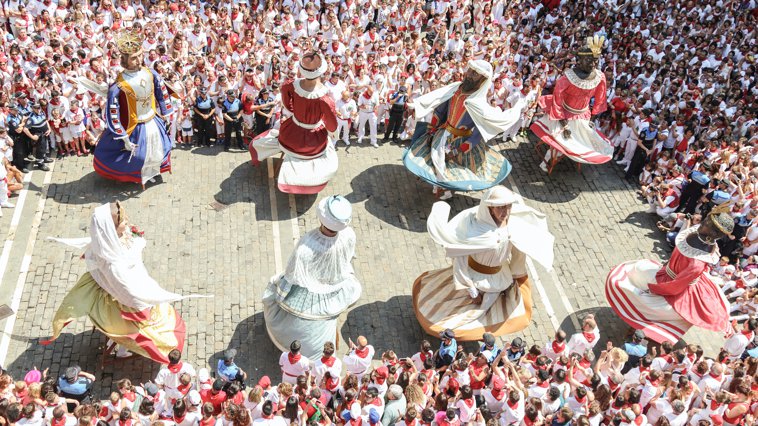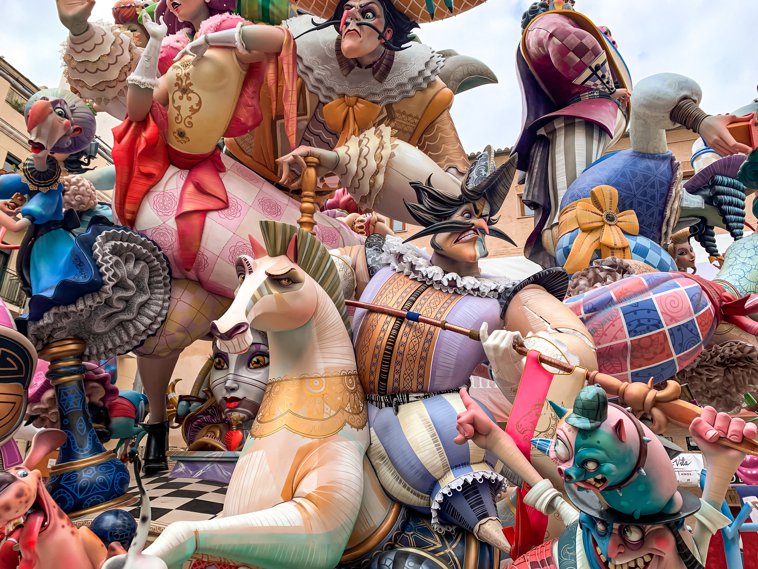Festivals in Spain
Questions This Article Answers
How to talk about festivals in Spain?
What are some examples of festivals in Spain?
What happens during Las Fallas?
What is the festival where people throw wine?
In Spain, the date of each town’s fiesta usually coincides with the saint’s day for the town’s patron saint. In some towns, the fiesta lasts for just one night. In others—usually big cities with big budgets—it can last for a week or two! Let’s learn more about fiestas in Spain.

Fiestas in Cities and Towns
Fiestas in Spanish cities tend to be multi-day events. In fact, many cities refer to their fiestas as the semana grande(big week)! What goes on during the semana grande will vary depending on the city, but there are a few common themes that you can find throughout Spain. Let’s take a look!
- Chupinazo: The chupinazo, literally translated as the loud shot, refers to a bottle rocket that is shot off, after a brief ceremony, to officially inaugurate the city’s festival.
- Atracciones(rides): Cities large and small will have atracciones for young and old. This is where Spanish fiestas most resemble American county fairs!
- Conciertos(concerts): From the banda municipal(town band) to hot national—and international!—acts, music is ever-present at fiestas.
- Cultura(culture): Culture in fiestas is not just limited to music. You’ll often find teatro(theater), folklore(folklore), exhibiciones de arte(art exhibits), and much more!
Fiestas in Small Towns and Villages
Fiestas in Spain’s smallest towns and villages tend to last just one day. They often include conciertos and cultura, like in cities, but they can also include activities that would be logistically impossible in bigger locales! For example, many small towns hold a parrillada(barbecue), or a similar meal, for the fiesta attendees. Concursos(competitions) are also popular, and often feature sports or cooking.
The religious aspect of the fiesta also tends to be more present in smaller towns and villages. For example, some towns celebrate a misa(mass) for the town’s patron saint and hold a procesión(procession) through town with the image of the saint!
Unique Fiestas You May Not Have Heard Of
While San Fermín and La Tomatina often make Spanish textbooks, have you heard of the following celebrations?
La Batalla del Vino in Haro
Harois located in La Rioja, a region enófilos(oenophiles) are sure to recognize! It’s where some of the country’s oldest and most well-known bodegas(wineries) are located. But did you know that, on el día de San Pedro(Saint Peter’s Day)—June 29—there’s a massive batalla de vino(wine fight) just outside of town?
People begin trekking to the hill where the wine fight takes place early in the morning. They wear white clothes, often accented with red pañuelos(bandanas) and belts. After a brief mass, a signal is given, and the batalla begins! Thousands of gallons of wine are thrown every year, and nobody is spared. White clothes turn a purplish-pink hue as neighbors, friends, and strangers throw wine at each other.
Las Fallas in Valencia

Las Fallasare celebrated in Valencia, on Spain’s Mediterranean coast, from March 15-19. They end on el día de San José, Saint Joseph’s Day. If you like fireworks and the noise they produce—this is the fiesta for you! Be prepared for crowds and noise; this is not a calm and quiet affair!
Each year, groups called comisiones fallerashire artists to build statues called fallasto be exhibited—and then burned!—during the festival. These statues are made of simple materials, such as paper maché, wood, metal, and cardboard, and they usually represent images related to current affairs or pop culture. They are gorgeous, lifelike, ephemeral statues whose destiny is predetermined: they all go up in flames on the evening of March 19!
Another unique aspect of the Fallas is the mascletà, a word in valenciano(Valencian), the local language. A mascletà is a very loud firecracker and fireworks display.
This festival is so unique and so important that it is on UNESCO'S List of Intangible Cultural Heritage.
Spanish Words to Talk About Fiestas
Here’s some vocabulary that’ll come in handy if you’re off to a fiesta!
Does all this talk about fiestas have you wanting to learn more? Check these articles out!














